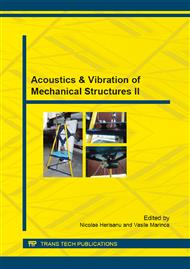[1]
European Parliament and the Council of the European Union. Directive 2002/44/EC on the minimum health and safety requirements regarding the exposure of workers to the risks arising from physical agents (vibration) (2002).
Google Scholar
[2]
ISO 2631-1: 2001. Mechanical vibration and shock – Evaluation of human exposure to whole-body vibration – Part 1: General requirements (2001).
DOI: 10.3403/30197820
Google Scholar
[3]
P. Bratu, Dynamic interaction between the foundations and the unbalanced rotating machine, 21st International Congress on Sound and Vibration 2014, ICSV 2014, 1, pp.602-607 (2014).
Google Scholar
[4]
P. Bratu, Physical instability and functional uncertainties of the dynamic systems in resonance, Applied Mechanics and Materials, 430, pp.32-39 (2013).
DOI: 10.4028/www.scientific.net/amm.430.32
Google Scholar
[5]
P. Bratu, Corrective analysis of the parametric values from dynamic testing on stand of the antiseismic elastomeric isolators in correlation with the real structural supporting layout, Applied Mechanics and Materials, 430, pp.305-311 (2013).
DOI: 10.4028/www.scientific.net/amm.430.305
Google Scholar
[6]
P. Bratu, Evaluation of the dissipated energy in viscoelastic or hysteretic seismic isolators, Romanian Journal of Acoustics and Vibration, 9 (1), pp.53-56 (2012).
Google Scholar
[7]
P. Bratu, The variation of the natural frequencies of road vibrator-rollers, as a function of the Parameters of Neoprene Vibration Isolation Elements, Materiale Plastice, 48 (2), pp.144-147 (2011).
Google Scholar
[8]
O. Vasile, Dynamic Behaviour Analysis of Machines in Transient Regime on Torsional Vibration Stresses, Romanian Journal of Acoustics and Vibration, 10 (2), pp.129-134.
Google Scholar
[9]
P. Bratu, Vibration of elastic systems, 600 pages, Technical Publishing House, Bucharest. (2000).
Google Scholar
[10]
M. Ciuncanu, Test performance evaluation for elastomeric anti-seismic devices on specialized stands with controlled generation excitation functions, 22th International Congress on Sound and Vibration, Florance, Italy, 12-16. 07. (2015).
Google Scholar
[11]
M. Ciuncanu, The influence of the excitation signal form on the evaluation of the damping characterics of the elestomeric antiseismic isolators, Bucuresti, SISOM 30-31 mai (2013).
Google Scholar
[12]
C. Alexandru, Influence of position angle of elastic anti-vibration elements on the transmissibility, (2014) Romanian Journal of Acoustics and Vibration, 11 (1), pp.59-62.
Google Scholar
[13]
C. Alexandru, Analysis of the dynamic behavior of the antiseismic elastomeric isolators based on the evaluation of the internal dissipated energy, Applied Mechanics and Materials, 430, pp.317-322 (2013).
DOI: 10.4028/www.scientific.net/amm.430.317
Google Scholar
[14]
V. Iancu, G.R. Gillich, C.M. Iavornic, N. Gillich, Some models of elastomeric seismic isolation devices, Applied Mechanics and Materials, 430, pp.356-361 (2013).
DOI: 10.4028/www.scientific.net/amm.430.356
Google Scholar
[15]
G.R. Gillich, Z.I. Praisach, Modal identification and damage detection in beam-like structures using the power spectrum and time-frequency analysis, Signal Processing, 96 (Part A), pp.29-44 (2014).
DOI: 10.1016/j.sigpro.2013.04.027
Google Scholar
[16]
P. Bratu, Elastic bearing systems for machines and equipment, 260 pages, Technical Publishing House, (1990).
Google Scholar
[17]
P. Murzea, Analysis of the behavior of large-span structures in the case of ambient vibrations considering the variety of motion possibilities, Romanian Journal of Acoustics and Vibration, 10 (1), pp.39-46 (2013).
Google Scholar
[18]
Information on http: /www. ni. com/white-paper/6957/en.
Google Scholar


